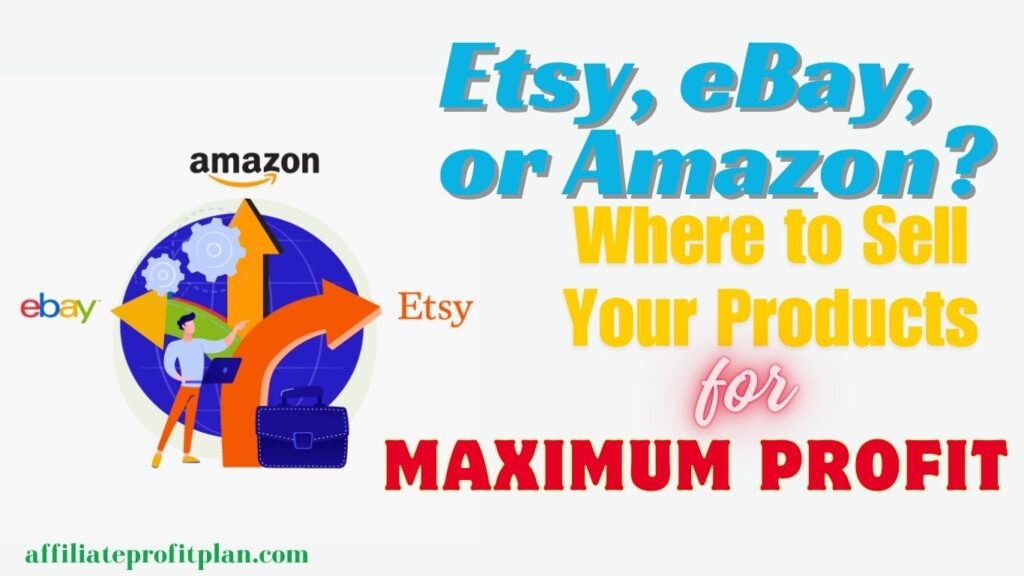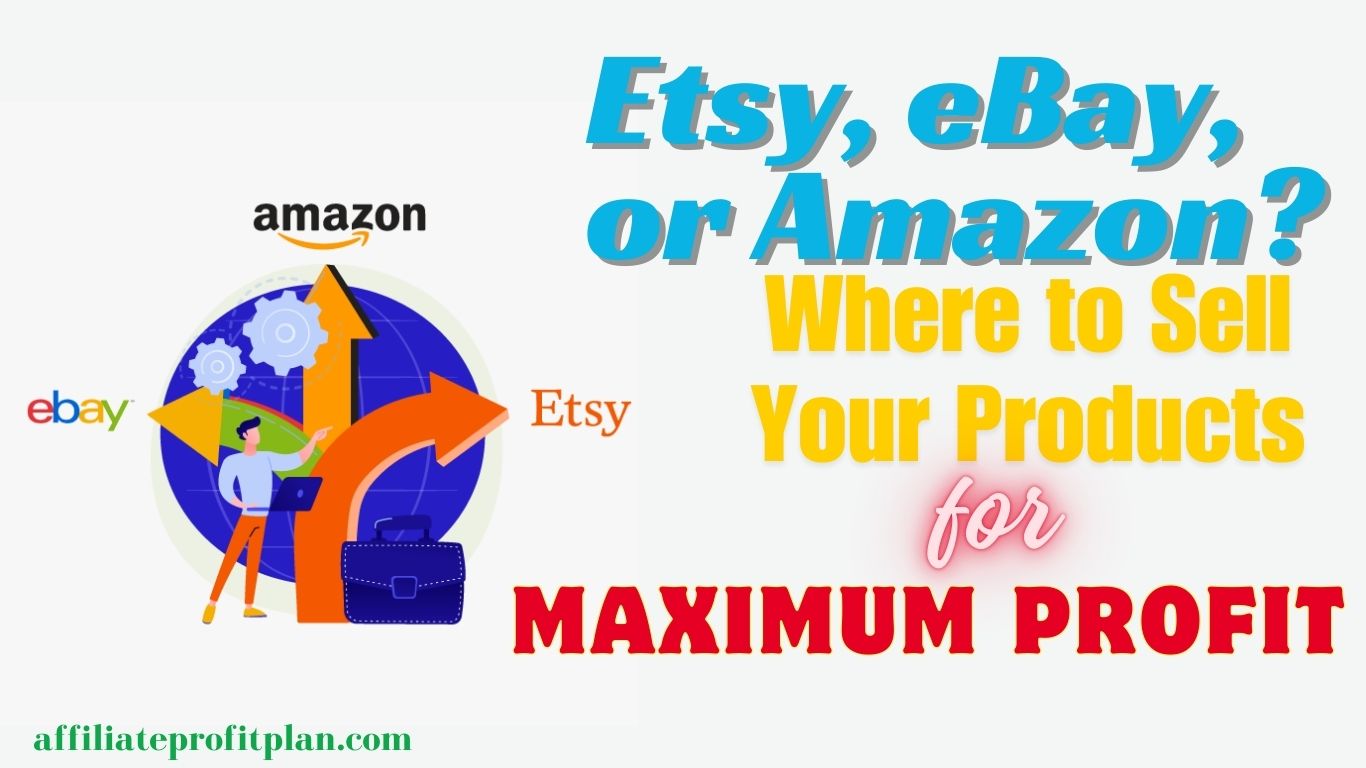Welcome to my article Etsy, eBay, or Amazon? Where to Sell Your Products for Maximum Profit. You’ve got a killer product — maybe it’s a handmade candle that smells like a beach vacation, a vintage camera from the 90s, or a custom T-shirt design that’s one sarcastic quote away from going viral. But now, the real question is: Where do you sell it? You’ve got three heavy hitters in the online marketplace ring: Etsy, eBay, and Amazon. They all promise profits, but each comes with its own quirks, fees, and audiences that can make or break your success.
In this article, we’re going to break down each platform — like a marketplace matchmaking session — to help you figure out where your product will thrive and, more importantly, make you money. Whether you’re an artisan hoping to find your niche, a reseller looking to turn items into cash, or an entrepreneur ready to scale, the right platform can give your sales a serious boost. But pick the wrong one, and you might end up staring at your empty storefront, wondering if it’s time to take up knitting instead.
So grab a coffee, get comfy, and let’s dive into the world of Etsy, eBay, and Amazon. Spoiler alert: the best marketplace for your product might not be the one you think.
Access My Proven Blueprint for $50-$100 Daily Income – Watch This FREE Video Now >>>

The Online Marketplace Showdown
Alright, folks — it’s time for the main event. In one corner, we have Etsy, the home of all things handmade, vintage, and DIY. In the other corner, there’s eBay, the digital garage sale turned global marketplace. And last but definitely not least, Amazon, the giant that sells everything from books to, well, basically everything under the sun. These three are the heavyweights in the e-commerce world, but which one is right for you?
Let’s be real: finding the perfect marketplace to sell your product is like choosing a dance partner. Sure, they all have their perks, but not every marketplace will lead you to the profits you’re dreaming of. Etsy is great for the artsy, niche creator who wants to show off their creativity, but it’s also a crowded room where standing out is a bit of a challenge. eBay is perfect for collectors and bargain hunters, but it’s got a bit of a Wild West vibe — flexible but often unpredictable. Then, there’s Amazon, the beast of global e-commerce, where you could be selling next to a multinational company — and that’s a whole other kind of competition.
In this showdown, we’ll be diving deep into each platform’s unique strengths and weaknesses, so you can make an informed choice about where to sell. Whether you’re looking for long-term growth or a quick cash grab, your product deserves a platform that helps it shine, not get lost in the digital shuffle. So, buckle up. This is going to be a fun ride — with lots of profits at the finish line!
Etsy: The Handmade, Artsy, and Niche-Friendly Giant
Etsy is like that cozy little boutique down the street, but online and with a touch of magic. If you’re a creator, artist, or maker with a product that has a personal touch, Etsy is basically your e-commerce soulmate. Think: handmade jewelry, custom T-shirts, vintage vinyl records, or even that quirky, one-of-a-kind plant pot you designed while binge-watching Netflix. Etsy is the place where your unique creations can find their audience.
One of the best things about Etsy? It’s built for the artsy types. If you’ve got a product that’s a little out-of-the-box, quirky, or just too cool for the mainstream, Etsy is your playground. Its community is made up of buyers who are actively searching for things that are different, creative, and not something you’ll find on a Target shelf. So, if you’re making something from scratch or selling vintage finds, this is a marketplace that appreciates creativity over mass production.
But let’s get into the nitty-gritty — the fees. Etsy charges a $0.20 listing fee per product (think of it like paying for your online shop’s cover charge), and then there’s a 5% transaction fee and a 3% + $0.25 processing fee for payments. The good news is you’re paying for a platform that brings in buyers who want to find your product. The bad news? With millions of active sellers, the competition can be fierce, and you’ll need a strong brand and marketing strategy to stand out.
The other cool thing about Etsy? It’s built for niches. Love designing custom pet tags for dogs named “Biscuit”? There’s an audience for that. Obsessed with creating plant-themed wall art? Etsy’s got you. You’re not just one of thousands of sellers in a sea of generic products. Etsy encourages you to create for specific interests and passions — and there’s always someone out there willing to pay for that unique, personal touch.
The downside? Etsy’s success requires a bit of hustle. You’ll need to be proactive about SEO, photography, and customer service if you want to really see those sales numbers climb. It’s not just a marketplace — it’s a community, and your shop should feel like a welcoming space for buyers who want to connect with the artist behind the work.
So, if you’re looking to sell products that tell a story, have personality, and cater to a creative or niche audience, Etsy is the perfect place to let your entrepreneurial spirit run wild. Just remember: it’s not just about the product, it’s about creating an experience.
eBay: The Auction King Turned Global Retail Platform
eBay is like that friend who’s always up for a good bargain and can sniff out a hidden treasure from a mile away. Once known for its quirky auctions (think: “Who will pay the most for a signed baseball from 1987?”), eBay has since evolved into a global retail powerhouse. It’s no longer just a digital yard sale; it’s an online marketplace for everything from collectibles and refurbished electronics to new clothing and automotive parts. If you’re looking to sell stuff that doesn’t quite fit into the handmade category of Etsy but still deserves a home, eBay could be your perfect match.
Access My Proven Blueprint for $50-$100 Daily Income – Watch This FREE Video Now >>>
One of the things that sets eBay apart is the auction format. Unlike other platforms, you can list your items to be bid on by eager buyers. If you’re selling something unique or rare, like vintage concert tickets, limited-edition sneakers, or even an antique teapot, auctions create a sense of excitement — and competition. That means you could end up with a sale price way higher than you expected (hello, happy surprise). Of course, this also means you’re gambling a bit. That teapot could sit there for days with no bids, or it could spark a bidding war.
But eBay isn’t just for auctions anymore. They’ve embraced the world of fixed-price listings too. If you’re selling newer products or things people want right now (like phone accessories, gadgets, or even pre-owned textbooks), a fixed-price option may be the way to go. The platform’s global reach allows you to tap into international markets, making it easier than ever to reach buyers who are looking for your specific products. Whether you’re selling vintage toys, refurbished laptops, or that vintage Gucci handbag you never wear, eBay provides the exposure to get your products into the hands of those who are actively hunting for them.
Now, let’s talk about fees. eBay’s fee structure is a bit like navigating a maze, but in a good way. eBay takes a percentage of your sale price (typically 10-12% for most categories) plus a payment processing fee. If you opt for the auction format, there’s a listing fee for some items as well, but the beauty of eBay is its flexibility — you can adjust your strategy based on what you’re selling and the audience you’re targeting. If you’re selling high-ticket items or bulk lots, those fees add up, but with the right product, you can definitely offset that cost.
Another thing to keep in mind? Customer expectations on eBay can be… a bit intense. Buyers are looking for deals, and they’re used to negotiating. If you’re selling used or pre-owned items, condition matters — and people are likely to ask a ton of questions (read: they’re not shy). To be successful here, you’ll need to be transparent, quick to respond, and clear about any wear and tear your product may have.
In short, eBay is the place to go if you want to move a lot of products, test different pricing strategies, or tap into markets beyond your local reach. Whether you’re an entrepreneur reselling items, or just cleaning out your garage and turning junk into cash, eBay has a space for you. You’ve got the flexibility to run your store your way — just be prepared to hustle for those listings and manage your customer expectations with a little extra finesse.
Amazon: The E-Commerce Powerhouse for High Volume Sales
If eBay is the scrappy, entrepreneurial marketplace and Etsy is the artsy haven for creatives, Amazon is the big leagues of online selling. This is the platform where global brands and eager side-hustlers alike rub elbows in the giant digital mall of the internet. Amazon isn’t just a marketplace; it’s an entire e-commerce ecosystem. Want to sell everything from baby wipes to Bluetooth speakers? You can do it here — and probably make a killing. The real question is: can you navigate its complex waters and still come out ahead?
When you sell on Amazon, you’re playing on a global stage. The platform’s reach is unparalleled, with millions of active users worldwide looking for just about anything — from everyday essentials to the next big tech gadget. If you’ve got a mass-produced product, a private label item, or even a drop-shipping operation, Amazon is the place to scale. You’re not just competing with local stores or niche buyers; you’re going toe-to-toe with massive retailers. That means if you want to stand out, you need to bring it. If you can master Amazon’s system (and all its quirks), you’ll be in the fast lane to high-volume sales and a steady stream of revenue.
What’s the secret sauce to success on Amazon? FBA — Fulfillment by Amazon. This service allows you to ship your products directly to Amazon’s warehouses, where they’ll store and fulfill your orders. Buyers love this because they can get their products in two days (thanks, Prime), and you love it because Amazon handles all the packing, shipping, and customer service for you. In theory, that means you can focus on finding products to sell and scaling your business, while Amazon does the heavy lifting.
But before you get too carried away imagining all those ka-ching! notifications, let’s talk about fees. Amazon takes a chunk — and it’s not shy about it. There’s a referral fee that ranges from 6% to 45% depending on the category of your product, plus any Fulfillment by Amazon (FBA) fees for storage and shipping. If you’re on the Professional Seller plan, you’ll also pay a monthly fee of $39.99. Those fees can add up fast, but if you’re selling products that move quickly or are in high demand, the volume can offset the cost. Note to self: Make sure to factor in those fees when pricing your products, or you might be left with a nice Amazon bill and zero profits to show for it.
Here’s where it gets interesting: Amazon is not for the faint of heart. It’s a fast-paced marketplace where success is often determined by reviews, ratings, and your ability to navigate Amazon’s strict policies. One bad review can send your sales crashing, and any misstep in the FBA process can result in delays, unhappy customers, and penalties. It’s a jungle out there — but it’s the kind of jungle where the animals (aka your competitors) are also trying to make a living. You’ll need to be on top of your game when it comes to inventory management, customer service, and optimizing your listings with the right keywords.
But if you’re looking to scale fast, and you’re ready to compete with the big dogs, Amazon is where the action is. It’s the ultimate platform for high-volume sales — especially if you can tap into what buyers are looking for and position your product just right. Sure, it’s tough to break in, but once you’re established, you could be sitting on a steady stream of sales that have you wondering why you didn’t start sooner.
In short, if you’re ready to play at a larger scale, can manage inventory and overhead, and want to reach global customers without building a storefront from scratch, Amazon is your e-commerce powerhouse. The question is: Are you ready for the challenge?
Comparing Profit Potential: What’s Best for Your Business?
Alright, we’ve done the deep dive into Etsy, eBay, and Amazon, and now it’s time for the million-dollar question: Which platform is going to make you the most money? Spoiler alert: there’s no one-size-fits-all answer. The best marketplace for your business depends on a whole bunch of factors, like your product type, pricing strategy, time commitment, and long-term goals. But don’t worry, we’ve got you covered. We’re about to break it down so you can see the profit potential of each platform and figure out which one matches your hustle.
Let’s start with Etsy. If you’re a creator with a unique, handmade product (think: artisanal candles, custom jewelry, or quirky wall art), Etsy is a goldmine waiting to be tapped. The buyers here are looking for something special, and if you can carve out your niche, you could do really well. The downside? Etsy’s fees can add up, especially as your shop grows, and competition is fierce. You’ll need to pour some serious effort into SEO, marketing, and crafting a memorable brand if you want to stand out in a sea of other creative sellers. The beauty of Etsy, though, is that if you’re successful, you could build a loyal community of customers who come back for more — making your revenue more sustainable over time. The profit potential here is good to great, especially if you hit the right balance of quality and visibility.
Now, let’s talk about eBay. If you’re selling secondhand goods, collectibles, or anything that doesn’t fit neatly into the “handmade” category, eBay could be the ticket to a solid side income or even a full-fledged business. eBay’s auction format gives you the chance to sell rare or high-demand items at prices above retail, which means your profit margins can really soar on the right products. That said, listing fees, final value fees, and shipping costs can eat into your profits, so you’ll want to make sure you’ve priced everything correctly. The real profit potential on eBay comes from volume — if you’ve got a lot of inventory, or if you can get your hands on hot-ticket items, you can turn a decent profit. But again, eBay is a bit more of a game of chance; a hot auction could net you a big win, but an overlooked listing might sit there with no bids. So, if you’re ready to hustle, track market trends, and manage inventory, eBay’s profit potential is solid and potentially lucrative.
And then there’s Amazon. If you’re looking to scale big, this is the platform where high-volume sales reign supreme. The profit potential on Amazon is absolutely massive, but only if you’ve got the right product and can handle the complex logistics of managing an Amazon business. The beauty of Amazon is that the volume is HUGE — with millions of buyers searching for just about anything, you’ve got an ocean of opportunity. But that also means you’re competing with large brands, big-box retailers, and other entrepreneurs. If you can tap into what’s hot and manage your listings properly, Amazon offers the highest potential profits — especially with FBA (Fulfillment by Amazon) helping you scale. The trade-off is competition and fees — Amazon’s cut can be steep, and you’ll need to navigate their rules and regulations carefully. So, if you’ve got the stamina and resources to handle the volume and complexity, Amazon offers the best chance for high-volume profits.
So, what’s the best choice for your business? It really depends on your goals:
- Etsy is perfect for creative types who want to build a niche brand with a loyal following. It offers great profit potential if you’re in the handmade or vintage space.
- eBay is the go-to if you want flexibility with auctions, secondhand goods, or collectibles. You’ll find solid profit opportunities, but be prepared for a bit of unpredictability.
- Amazon is ideal for entrepreneurs looking to scale quickly and tap into high-volume sales, but it comes with the challenge of stiff competition and higher fees.
Ultimately, if you’re just starting out, you might want to test the waters with multiple platforms. You could sell handmade jewelry on Etsy, flip vintage electronics on eBay, and test out some wholesale products on Amazon — that way, you can figure out where your products perform best and focus your efforts where you’ll see the highest profits. Each marketplace has its own strengths, but the right choice depends on your product and business strategy.
Conclusion: Pick Your Platform, Maximize Your Profit
Alright, we’ve broken down the pros, cons, and profit potential of Etsy, eBay, and Amazon. Now comes the fun part — deciding where to park your virtual shop and start making those cha-ching sounds in your bank account! But don’t stress, the right platform for you will depend on your unique business, goals, and the kind of products you’re selling. It’s not about finding the platform — it’s about finding your platform.
Access My Proven Blueprint for $50-$100 Daily Income – Watch This FREE Video Now >>>
Etsy is the place for those with a creative spark. If your products have a personal touch, are handmade, or even vintage, Etsy lets you showcase your individuality while tapping into a community of like-minded buyers who appreciate craftsmanship. It’s perfect for small-scale creators looking to build a passionate fanbase and a loyal customer base. Just remember, the competition is fierce, so standing out will take a little hustle, SEO magic, and an eye for branding. But if you’re willing to put in the work, Etsy can deliver steady, long-term profits with a community vibe that’ll make your entrepreneurial heart sing.
eBay, on the other hand, thrives on flexibility. Whether you’re selling pre-owned goods, collectibles, or things that don’t quite fit into the handmade category, eBay offers a more unpredictable but rewarding ride. Auctions add that excitement (and potential for a bidding war!), and fixed-price listings help you sell fast. If you’ve got the patience to play the volume game, navigate fees, and stay on top of shipping, eBay offers plenty of opportunities to rake in profits. Plus, with its global reach, you can sell to customers who might be looking for that specific item only you have.
And then there’s Amazon. If you’re looking for scale — and we’re talking big scale — this is where you want to be. Amazon’s profit potential is unmatched when it comes to volume sales and global exposure. It’s not for the faint of heart, though. The platform’s complexity, stiff competition, and hefty fees can be overwhelming, but if you’ve got a solid product and a game plan for navigating the jungle, the sky’s the limit. With FBA helping to take the load off, you can focus on growing your business while Amazon handles logistics, customer service, and shipping.
So, what’s the bottom line? If you’ve got a creative product that speaks to a niche market, Etsy’s where your talents can shine. If you’re all about selling and reselling or dealing with high-ticket, one-off items, eBay’s the perfect place for your hustle. And if you’re looking to scale big, manage high-volume sales, and tap into a global customer base, Amazon is where the profits can really stack up.
At the end of the day, it’s not just about choosing a platform — it’s about picking the one that aligns with your business goals. Consider your product, your target audience, and your long-term vision. You don’t have to stick to just one, either. Many sellers juggle multiple platforms, testing the waters to see which one brings in the most cash. But once you find your sweet spot, buckle up — because with the right platform, a solid strategy, and a little bit of hustle, you’ll be on your way to maximizing your profit in no time.
Now, go ahead and choose your platform — and let’s get selling!
Thanks a lot for reading my article on “Etsy, eBay, or Amazon? Where to Sell Your Products for Maximum Profit” till the end. Hope you’ve helped. See you with another article.










